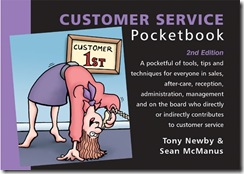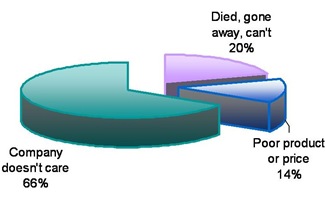In business today, price is no longer a major differentiator. So many companies offer promotional promises and will try to undercut their competition. The one aspect that will mean your customers come back to you is how they are treated and the level of customer service. There are some statistics to support this:
- A company can increase profits by 85% if it retains 5% more customers each year.
- It is 5-8 times as easy to sell to an existing customer as to a new prospect.
- Some direct mailing tests to groups of “customers” and “prospects” found that approaches to customers were four and a half times more profitable than approaches to prospects.
Source: Research from Bain & Co
Customer service is all about attitude.
Nurturing and retaining customers is crucial to the success of your business. Customer service is all about attitude rather than techniques. A member of staff can have all the techniques in the world but if they do not believe in the business and do not want to do it, they won’t. Are all your staff focused on making the customer the focus of their world?
The Big Secret to Customer Care
… is to care!
What do customers really want? The most important thing you can do for your customer is listen to what they want and be open about whether you can provide it. The big secret to customer care is to care enough to listen, and to respect what you hear, so:
- Be welcoming
- Ask questions
- Listen carefully
- Offer only goods or services that truly meet their needs
Satisficing
‘Satisficing’ is doing the minimum to meet a set of criteria. This is the approach that many organisations take to customer care. It is certainly the easiest way to deal with complaints. Easiest is rarely best – and certainly not in this case. Treat complaints as an opportunity to have a good long conversation with your customer and go way beyond satisficing. Go beyond pleasing; aim to delight.
A recent customer service experience taught me a real lesson. I bought a new service which didn’t work first time. I contacted technical support, who first denied there could be a problem, and then treated me as if I were foolish “You don’t do it like that – that won’t work …”. After many calls, I did speak to one engineer who said (I am quoting verbatim – I wrote it out in my daybook): ‘this is a bug’.
After a week of ever more frustrating emails, I figured out what to do. The service worked perfectly, the advice on an online forum was good. The customer care, however, means I’ll never recommend that service to anyone without warning them. If an email takes three minutes to rush off, it will only take five to write with care. Word of mouth is the best – no, THE BEST – source of new business. Are you chasing quick responses from your staff or are you seeking first class customer service?
A Customer Care Review
When did you last have your monthly customer care review? Thought so! Set one up, if your answer was not 31 days ago or less. Here are five great questions to ask your colleagues and discuss:
- What annoys our customers most at the moment? If you don’t know: ask them.
- What have we improved on customer care this month? This is what your customers notice, not what you worked hard on.
- How do we compare with our competitors? What are people saying on forums, for example?
- What are we doing to really delight our customers at the moment? Go beyond satisficing.
- Is it time for a “mystery shopper”? There are a number of companies who can offer this service, but unless you are a small business, you can do it for yourself.
Moments of Truth
Moments of Truth are those tiny moments when a customer learns something about your business organisation. Every interaction, however small, has a moment of truth in it. What will that truth be?
What does your front door look like? Estate agents will tell you that it is easy for viewers to fall in love or out of love with a house, based on its front door. We aren’t saying repaint your front door when you want to sell your house (though you should): we are saying get the entrance and reception area of your business right. Tomorrow morning, come in through the customer entrance and see it through a customer’s eyes.
Director of Welcoming
Okay, you say receptionist, I say Director of Welcoming. A receptionist sits behind a reception desk, takes names, and makes calls. A Director of Welcoming welcomes people in and then does everything they can to make them feel welcome. Small difference in the work: vast difference in the results.
First impressions really do matter. It might be the voice on the end of the phone when a new customer first calls. It might be the first email or letter a new client gets. It might even be the greeting they get when they first visit your office, factory or warehouse. What’s the common thread? Your receptionist. And often these undervalued colleagues are required to multitask with the minimum of training. This is just plain wrong, because it puts your business in danger.

Three pocketbooks you may like:



 Just before Christmas, news came out that Google has updated the way its search engine works, so that it
Just before Christmas, news came out that Google has updated the way its search engine works, so that it  Google holds a huge amount of data about customer behaviour that could also be factored in. Let’s not forget that Google knows how often people search for your company name together with ‘complaints department’.
Google holds a huge amount of data about customer behaviour that could also be factored in. Let’s not forget that Google knows how often people search for your company name together with ‘complaints department’.

 About twelve years ago, I participated in some research that ultimately led to what its authors hoped would be a ground breaking book: ‘
About twelve years ago, I participated in some research that ultimately led to what its authors hoped would be a ground breaking book: ‘

